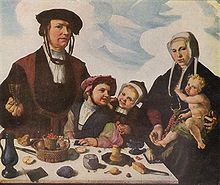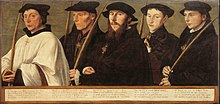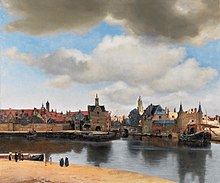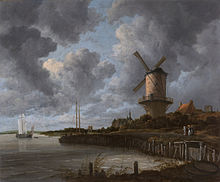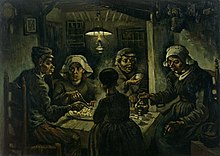Netherlands painting
Painting from the Netherlands is a polysemic and equivocal expression, which can refer both to painting made in what is now called the Kingdom of the Netherlands and to the totality of what is known as painting. Flemish, a concept that includes that carried out in any of the territories of the Habsburg Netherlands (which was also made up of what is currently called the Kingdom of Belgium and the Grand Duchy of Luxembourg, among others). To differentiate the painting from the "Northern Netherlands" from that of the "Southern Netherlands" art historiography often uses the names Dutch painting or Dutch painting, or Dutch school of painting, despite its inappropriateness (Holland is only one of the United Provinces of the Netherlands, although the most important, especially due to the economic and cultural power of its capital, Amsterdam).
The stylistic differentiation between southern and northern Flemish painting did not occur until the XVII century (the so-called golden age of Dutch painting), since the fluid exchanges between the masters and workshops of both areas continued to be maintained even despite the long period of civil and religious wars known as the Eighty Years' War (1568-1648), which it defined the separation between the south (catholic and integrated in the Hispanic Monarchy) and the north (protestant and independent). A decisive event was the decline of Antwerp, which had been the economic and artistic center not only of the region, but of all of northern Europe: from the sack of Antwerp (1576) and the siege of Antwerp (1584-1585). many artists went to seek refuge in the cities of the north, which not only benefited Amsterdam (turned into the new economic and cultural center), but also Haarlem (Haarlem school -Karel van Mander, "the Vasari of the North"-) and even to bordering areas, in present-day Germany (Frankenthal school).
Painting (Rembrandt, Vermeer, Van Gogh, Mondrian, Escher) stands out above the other forms of art in the Netherlands, although there are also notable forms of sculpture (Adriaen de Vries), architecture and design (Theo van Doesburg -De Stijl-), music (Jan Pieterszoon Sweelinck) or literature.
Late Middle Ages and Renaissance
The Flemish Primitives are so called regardless of their place of birth or the city where they established their workshop. This is the case with the Limbourg brothers (Nijmegen -three international Gothic miniaturists famous for their work for the Duke of Berry-), Dieric Bouts (Haarlem), Bosco (Bolduque) or Pieter Brueghel the Elder (Son en Breugel), who were born in localities in the northern Netherlands. Jan van Eyck and Petrus Christus were born respectively in Maaseik and Baarle, towns located on the current border between the two countries, which then lacked any meaning.
Albert van Ouwater is considered the founder of the Haarlem school, teacher of the more famous Geertgen tot Sint Jans, whose best-known work is perhaps the altarpiece for the chapel of the Knights of St. John (Haarlem). Jan van Scorel, based in Utrecht, represents the importation of the Italian style. The portraitist Antonio Moro and Martin van Heemskerck were his students.
Baroque: the Golden Age
At the end of the 16th century many painters from Flanders fled to the northern Netherlands, for religious reasons and also because they were growing economically. Both regions had a Golden Age of painting at this time due to the enormous quantity and quality of their painters and the diversity of pictorial schools.
The Caravagism that began to spread at the beginning of the XVII century through Italy reached the Netherlands through the Tenebrists from the so-called Utrecht school (Abraham Bloemaert).
The independence of the United Provinces consolidated the existence of a powerful mercantile bourgeoisie, which was now the main demander of easel paintings; The clergy and the nobility were no longer the main clients of the plastic artist. This type of bourgeois clientele had a different taste, expressed in the preference for themes that until then had been secondary in relation to history painting: landscapes, portraits (particularly the collective portraits of the collegiate directives of some institutions), the still life and the genre scene that tries to represent everyday life.
The most important Dutch painter of the time was Rembrandt, but there were many other great masters with workshops located both in Amsterdam and in various parts of the Dutch geography. Frans Hals, the Flemish Adriaen Brouwer, Adriaen van Ostade and Gerard ter Borch worked in Haarlem, with a production of works of a realistic nature. Jan van Goyen and Jan Steen lived in Catholic The Hague. The intimate genre scene reaches its full splendor with Delft artists: Pieter de Hooch and, above all, Jan Vermeer.
Other great Dutch painters of the 17th century include:
18th century
Dutch artists of the 18th century are less well known. I would only highlight the landscape painting, especially the seascapes. European tastes fell under the orbit of the French rococo, which cultivated a type of painting very different from the traditional Dutch one, and which would have its best representatives in Fragonard and Boucher. Nor did it shine especially in the ranks of eighteenth-century neoclassicism; Holland continued to paint floral still lifes, landscapes, and genre scenes, cultivating its own market.
19th century
Throughout the 19th century there were some Dutch painters of merit, such as the animal painter Pieter van Os; or the painter and photographer George Hendrik Breitner. But at the end of this century a truly great genius of painting appeared: Vincent van Gogh, who, however, developed the main production of him in France, without gaining recognition until after his death.
20th century
In the 20th century, the Netherlands produced many fine painters. Among them Piet Mondrian, whose abstraction was developed from the cubist grid, which he progressively reduced to horizontal and vertical lines that enclose planes of pure color. By simplifying it, the language of neoplasticism, the name he gave to his artistic doctrine, satisfied the artist's demands for universality. Mondrian is among the vanguard of non-figurative painting.
In the interwar period, Theo van Doesburg, after having been one of the main defenders of Neo-Plasticism, decisively renewed abstract art by maintaining that artistic creation should only be subject to controllable and logical rules, thus excluding any subjectivity. Kees Van Dongen is part of an expressionist style.
M. C. Escher developed a very personal work, with themes of great impact, both conceptual and visual, and compositions based on the effects of tessellations and recursion.
There were also Dutchmen among the post-WWII avant-garde movements, such as some of the members of the CoBrA movement, including Karel Appel and Corneille.
Museums with representation of the Dutch school
In the Netherlands
- Frans Hals Museum, Haarlem
- Rijksmuseum, Amsterdam
- Amsterdam Museum
- Mauritshuis, The Hague
- Museum Boijmans Van Beuningen, Rotterdam
- Centraal Museum, Utrecht
- Groninger Museum
- Gemeentemuseum (The Hague Municipal Museum)
In other countries
- Hermitage Museum, St. Petersburg
- Musée du Louvre, Paris
- Gemäldegalerie, Berlin
- Alte Pinakothek, Munich
- National Gallery, London
- Kunsthistorisches Museum, Vienna
- Musée Royal des Beaux-Arts d'Anvers
- Musées Royals des Beaux-Arts de Brussels
- Gemäldegalerie Alte Meister, Dresden
- Budapest Museum of Fine Arts
- Museo del Prado, Madrid
- Herzog Anton Ulrich-Museum, Brunswick
- Fitzwilliam Museum, Cambridge
- Statens Museum for Kunst, Copenhagen
- Detroit Institute of Arts
- National Gallery of Ireland, Dublin
- Galleria degli Uffizi, Florence
- Galleria Pitti, Florence
- Art Gallery of Glasgow
- Kunsthalle, Hamburg
- Staatliche Kunsthalle, Karlsruhe
- Windsor Castle, London
- Dulwich Picture Gallery, London
- Metropolitan Museum of Art, New York
- Ashmolean Museum, Oxford
- John G. Johnson Collection del Philadelphia Museum of Art
- Toledo Museum of Art (Ohio, United States)
- Stockholm National Museum
- Muzeum Narodowe, Warsaw
- National Gallery of Art, Washington
- Boston Museum of Fine Arts
- Isabella Stewart Gardner Museum, Boston
- National Gallery of Scotland, Edinburgh
- Iveagh Bequest in Kenwood House, London
- Victoria and Albert Museum, London
- Frick Collection, New York
- Musée du Petit Palais, Paris
- City Art Museum, San Luis
- Staatsgalerie Stuttgart
- Galleria Sabauda, Turin
Contenido relacionado
Inside Bjork
Vessel
Fidel Campina




